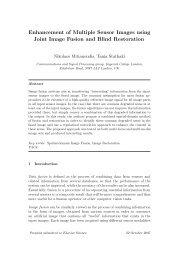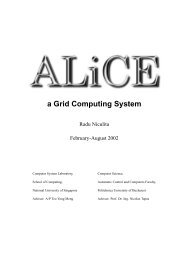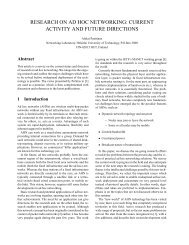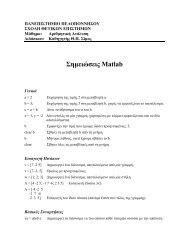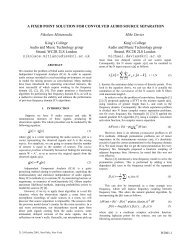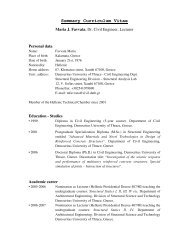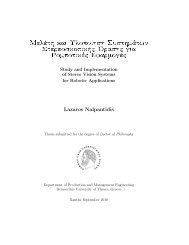WB-RTO: A Window-Based Retransmission Timeout for TCP - Utopia
WB-RTO: A Window-Based Retransmission Timeout for TCP - Utopia
WB-RTO: A Window-Based Retransmission Timeout for TCP - Utopia
Create successful ePaper yourself
Turn your PDF publications into a flip-book with our unique Google optimized e-Paper software.
<strong>WB</strong>-<strong>RTO</strong>:<br />
A <strong>Window</strong>-<strong>Based</strong> <strong>Retransmission</strong> <strong>Timeout</strong> <strong>for</strong> <strong>TCP</strong><br />
Abstract— We present a new timeout algorithm <strong>for</strong> <strong>TCP</strong>, based<br />
on the observation that <strong>TCP</strong>-<strong>RTO</strong> should not be solely based on<br />
RTT estimations. We argue that the design principles of the<br />
current timeout algorithm may lead to flow synchronization,<br />
unnecessary retransmission ef<strong>for</strong>t and unfair resource allocation.<br />
<strong>WB</strong>-<strong>RTO</strong> exhibits two major properties: (i) it cancels retransmission<br />
synchronization which dominates when resource demand<br />
exceeds by far resource supply and (ii) reschedules flows on the<br />
basis of their contribution to congestion.<br />
I. INTRODUCTION<br />
The retransmission timeout policy of standard <strong>TCP</strong> [14]<br />
is governed by the rules of RFC 2988 [13]. The algorithm<br />
is based solely on RTT measurements, trying to capture<br />
dynamic network conditions by measuring the variation of<br />
the RTT samples. In particular, the <strong>Retransmission</strong> <strong>Timeout</strong><br />
is calculated upon each ACK arrival after smoothing out the<br />
measured samples, and weighting the recent history. More<br />
precisely, upon each ACK arrival, the sender:<br />
• calculates the RTT Variation:<br />
RT T V AR = 3/4 × RT T V AR + 1/4 × |SRT T −<br />
RT TSAMP LE(1)<br />
• updates the expected RTT prior to calculating the timeout:<br />
SRT T = 7/8 × SRT T + 1/8 × RT TSAMP LE<br />
• and finally, calculates the <strong>Retransmission</strong> <strong>Timeout</strong> value:<br />
Ioannis Psaras and Vassilis Tsaoussidis<br />
Dept. of Electrical and Computer Engineering<br />
Demokritos University of Thrace<br />
Xanthi, Greece<br />
Email: {ipsaras, vtsaousi}@ee.duth.gr<br />
(2)<br />
RT O = SRT T + max(G, 4 × RT T V AR) (3)<br />
where, RTTVAR holds the RTT variation and SRTT the<br />
smoothed RTT. In Equation (3), G denotes the timer granularity,<br />
which is incorporated in order to assign a lower bound<br />
to the retransmission timeout to protect it against spurious<br />
timeouts (i.e. when RTT equals the timer granularity).<br />
Although the design of the timeout algorithm has been<br />
studied extensively in the past (e.g. [5], [8], [9], [11], [12],<br />
[13], [17], [19]), the association with its inherent scheduling<br />
properties has not really been evaluated adequately. Instead,<br />
much attention has been paid on its ability to reflect network<br />
delay accurately (e.g. [1], [3]), allowing <strong>for</strong> speedy<br />
retransmission when conditions permit and avoiding double<br />
submission due to early expiration. However, network delay<br />
as it is captured by measuring the RTT alone, cannot always<br />
capture the level of flow contention [16]. In this context, flows<br />
with large windows, a common situation when flow contention<br />
is low, do capture network delay with better precision: <strong>for</strong><br />
example, last packets of the same window will experience<br />
more delays. The situation appears to be very diverse when<br />
each flow is represented with a single-packet window, <strong>for</strong><br />
example.<br />
However, there are 3 points to make: 1) this diversity<br />
can only be reflected on the timeout when flows are not<br />
synchronized, 2) the responsiveness of the algorithm depends<br />
on the weighting of the measured samples and 3) all packets<br />
entering a full buffer experience the same delays, leading all<br />
flows to adjust to the same timeout value. Hence, it is possible<br />
<strong>for</strong> the timeout to shrink when contention grows, at least <strong>for</strong><br />
those flows that experience less delays in the queue [16].<br />
The problem of scheduling as it is associated with timeout<br />
has another dimension as well. When flows are synchronized,<br />
or becoming synchronized due to a congestion event, the<br />
timeout is adjusted accordingly <strong>for</strong> all participating flows.<br />
The existing policy to exclude the retransmitted (dropped)<br />
packets from measurements leaves little space <strong>for</strong> timeout<br />
differentiation among the participating flows, thus leading<br />
to possibly synchronized retransmissions. There<strong>for</strong>e, fairness<br />
cannot be guaranteed since flows are not randomly scheduled,<br />
but instead, are possibly partitioned into two groups: the one<br />
consisting of flows that utilize the link and the other consisting<br />
of flows that unsuccessfully attempt to enter at times when the<br />
link is utilized.<br />
The equations that <strong>for</strong>m the timeout algorithm (Equations<br />
(1), (2) and (3)) do not allow <strong>for</strong> differentiation among<br />
flows that experience the same queuing delay. For example,<br />
flows that enter a system simultaneously will be ordered in<br />
the queue and possibly follow the same order throughout the<br />
upcoming transmission rounds. Furthermore, flows that enter<br />
the system when the buffer is fully utilized, may also be<br />
excluded in the next rounds, <strong>for</strong> the same reason. Current<br />
timeout scheduling becomes deterministic, allowing only a<br />
particular set of participating flows to utilize the link.<br />
In this paper, we extend our previous study [16] in the sense<br />
that we still consider cases, where the timeout algorithm becomes<br />
the scheduler <strong>for</strong> the link. We present a new algorithm<br />
which records the congestion window and calculates the average<br />
window in order to capture how contention evolves with<br />
time. In addition, our algorithm uses the current congestion
window to assess the contribution of the flow to congestion.<br />
The RTT instead is only used to determine the lower bound of<br />
the timeout. We call our algorithm <strong>Window</strong>-<strong>Based</strong> <strong>RTO</strong>. We<br />
investigate the behavior of the proposed algorithm and find that<br />
<strong>WB</strong>-<strong>RTO</strong> cancels <strong>TCP</strong>’s inability to administer simultaneous<br />
retransmissions and consequently <strong>WB</strong>-<strong>RTO</strong> achieves higher<br />
goodput, better fairness, and less retransmission overhead.<br />
II. RELATED WORK<br />
Several researchers have reported problems regarding the<br />
<strong>TCP</strong>-<strong>RTO</strong> [5], [9], [12], [16], [17], [19]. Lixia Zhang, in<br />
[19], identifies several drawbacks of the <strong>TCP</strong> retransmission<br />
timer and reports its intrinsic limitations. The paper concludes<br />
that mainly external events should trigger retransmissions and<br />
timers should be used only as a last notification about packet<br />
loss. Although <strong>WB</strong>-<strong>RTO</strong> departs from a different point, it also<br />
alleviates problems reported in [19], due to the fact that these<br />
problems are mainly caused by the exclusive relation of the<br />
timers with the RTT.<br />
The Eifel Algorithm [9], [12], [8] focuses on spurious<br />
timeouts. The Eifel algorithm uses the <strong>TCP</strong> timestamp option<br />
[10], in order to detect spurious timer expirations. Once a<br />
spurious timeout is detected, the sender does not back-off, but<br />
instead it restores the transmission rate to the recorded rate<br />
prior to the timeout event.<br />
The Forward <strong>RTO</strong> Algorithm [17] targets the detection<br />
of spurious timeouts too. The algorithm instead of using<br />
timestamp options, it checks the ACK packets that arrive at the<br />
sender after the timer’s expiration, observes whether the ACKs<br />
advance the sequence number or not and finally concludes on<br />
whether the timeout was spurious or not.<br />
Both the above algorithms (Eifel [12] and F-<strong>RTO</strong> [17])<br />
improve <strong>TCP</strong>’s per<strong>for</strong>mance ( [2], [18]) significantly. However,<br />
none of them really solves the problems stated in [19], due<br />
to the fact that they do not modify the retransmission timeout<br />
algorithm itself, but instead they only change the response<br />
of the transport protocol after a timeout has occurred. More<br />
precisely, both algorithms ( [12], [17]) take into consideration<br />
outstanding data packets only after the timer expires, while<br />
the nature of the problem calls <strong>for</strong> modifications of the<br />
timeout itself. In this context, <strong>WB</strong>-<strong>RTO</strong> adjusts the timeout<br />
to an appropriate value which efficiently avoids unnecessary<br />
retransmissions (up to 500%), without impacting the goodput<br />
per<strong>for</strong>mance of <strong>TCP</strong> (see section V).<br />
In [16], we have shown that <strong>TCP</strong> timers, based solely on<br />
RTT estimations, do not always respond according to the level<br />
of flow contention. We investigated the behavior of <strong>TCP</strong> in<br />
high contention scenaria and confirmed that it is possible<br />
<strong>for</strong> the timeout to decrease when contention increases. We<br />
concluded that this anomaly is due to flow synchronization.<br />
Our analysis called <strong>for</strong> a new design, which should also<br />
account <strong>for</strong> approximation of the level of flow contention,<br />
along with a mechanism to cancel synchronization. We exploit<br />
these directives in the present work.<br />
III. <strong>WB</strong>-<strong>RTO</strong>: THE PROPOSED ALGORITHM<br />
We propose a new algorithm <strong>for</strong> the <strong>TCP</strong> <strong>RTO</strong> to: (i)<br />
practically approximate the level of contention, (ii) estimate<br />
the contribution of each flow to congestion and (iii) allow<br />
<strong>for</strong> asynchronous retransmissions, ordered in time in reverse<br />
proportion to their contribution to congestion. We note that<br />
(i), (ii) and (iii) <strong>for</strong>m a collaborative detect/respond scheme to<br />
increase efficiency of the system response, i.e. not a particular<br />
flow response. Clearly, if all flows calculate a single accurate<br />
time <strong>for</strong> retransmission, the system will fail to provide efficient<br />
service, due to flow synchronization. In this context, (iii)<br />
allows <strong>for</strong> better responsiveness to contention.<br />
A. Implementation<br />
During periods of high contention, it is possible <strong>for</strong> all flows<br />
to operate with minimal windows, in which case we induce<br />
randomization to guarantee timeout diversity. However, it is<br />
also possible <strong>for</strong> the contending flows to operate with different<br />
window sizes. In this case, we attempt to adjust the timeout<br />
according to the degree of their contribution to congestion,<br />
which is captured in parameter c. In particular 1 , we initially<br />
classify the flow depending on its current transmission window<br />
and charge it with an appropriate penalty (parameter c),<br />
according to the following observations: the current congestion<br />
window (cwnd ) is compared with the maximum congestion<br />
window (max cwnd ) that the flow has ever reached, since<br />
the connection establishment. In case the cwnd is smaller than<br />
half of the maximum congestion window, the flow is marked<br />
with the minimal charge (c = 1). If the flow’s cwnd belongs to<br />
the interval [max cwnd /2, (3/4)×max cwnd ), the penalty<br />
is higher (c = 1, 5). Finally, if the current cwnd lies in the<br />
remaining area ([(3/4)×max cwnd , max cwnd ]), the flow<br />
is given a major penalty (c = 2). The justification <strong>for</strong> the<br />
above policy is as follows: the penalty charged to the flow<br />
will influence the retransmission timeout value. The higher the<br />
penalty, the longer the <strong>RTO</strong>. This way, we attempt to punish<br />
flows operating with large congestion windows upon a timeout<br />
event, since the timer’s expiration is considered here as a<br />
congestion signal. On the contrary, a flow operating with small<br />
congestion window (compared to the maximum congestion<br />
window) has not contributed much to the network load and<br />
hence there is no need to be punished. The above statements<br />
are grafted in Equation (4) below.<br />
Next, we further classify the flow according to its (recent)<br />
congestion window history (average window, denoted<br />
as awnd ). We define four different thresholds 2 (Threshold<br />
1 to 4) and classify the flow according to its awnd value,<br />
which corresponds to the current level of flow contention (see<br />
Equation (5) below). Threshold1 corresponds to very high<br />
contention, while Threshold4 refers to the situation where<br />
1 The following proccess is triggered every time the <strong>RTO</strong> is calculated <strong>for</strong><br />
a specific <strong>TCP</strong> flow.<br />
2 Note that both the thresholds and the parameters discussed below are<br />
determined based on experiments and they constitute subject of further<br />
investigation (see section V.B).
congestion events happen sparsely. Throughout the experiments,<br />
Threshold1 (high contention) was set to 5 packets,<br />
while Threshold4 (low contention) was set 50 packets.<br />
We assign four multipliers (a1 to a4) corresponding<br />
to the four predetermined intervals ((0, T hreshold1) to<br />
(T hreshold3, T hreshold4)). More precisely, ai (where ai <<br />
ai−1) multiplies c in order to set the penalty and consequently<br />
the <strong>RTO</strong> based on both the window and its history (Equations<br />
(6) and (7). Summarizing, the first classification (i.e.<br />
parameter c in Equation 4) captures the contribution of the<br />
flow to congestion, while the second classification (Threshold<br />
1 to 4 in Equation (5)) gives an estimation of the level of flow<br />
contention.<br />
Finally, we randomly select a value from the interval (rtt,<br />
ai×c), where the lower bound, rtt, guarantees that the timeout<br />
will not expire prior to the RTT, preventing the algorithm<br />
from becoming too aggressive (Equations (6) and (7). The<br />
pseudocode is presented below:<br />
• compare cwnd with max cwnd and assign a penalty<br />
accordingly<br />
c = f(cwnd , max cwnd ) (4)<br />
• classify the flow to the appropriate Threshold, according<br />
to its awnd<br />
ai = g(awnd , T hresholdi) (5)<br />
• finally, calculate the <strong>Window</strong>-<strong>Based</strong> <strong>RTO</strong><br />
or<br />
W B − RT O = random(rtt, c × ai) (6)<br />
W B − RT O = random(rtt, f(cwnd , max cwnd )<br />
× g(awnd , T hresholdi))(7)<br />
where T hresholds 1 to 4 are set to 5, 10, 30 and 50,<br />
respectively and the corresponding parameters (a1, a2, a3, a4)<br />
are set to 10, 5, 3 and 2, respectively.<br />
B. Expected Behavior<br />
The proposed algorithm attempts to i) to incorporate the<br />
level of flow contention (Equation (5)), ii) penalize flows<br />
according to their contribution to contention (Equation (4)) and<br />
iii) schedule retransmission in a manner that synchronization<br />
is avoided (Equation (7)).<br />
In Figure 1, we present the behavior of <strong>WB</strong>-<strong>RTO</strong> <strong>for</strong> a<br />
wide range of average transmission windows. Three plots<br />
are presented in this Figure. Each line plot represents the<br />
response of <strong>WB</strong>-<strong>RTO</strong> relevant with the average transmission<br />
window <strong>for</strong> the three possible penalties. Three points are<br />
salient: i) the highest values (in average) <strong>for</strong> the retransmission<br />
timeout correspond to the highest penalties, ii) it is possible<br />
<strong>for</strong> a flow to calculate a small <strong>RTO</strong> even when it operates<br />
with large windows, iii) timeout settles to smaller values<br />
as the average window increases. Note that in all cases,<br />
Fig. 1. <strong>WB</strong>-<strong>RTO</strong> vs awnd<br />
we prevent the algorithm from calculating a timeout value<br />
smaller than the round trip time, since this would result in<br />
an undesirably aggressive behavior, which would negatively<br />
impact the system per<strong>for</strong>mance.<br />
C. Proof of Concept<br />
We provide a more detailed analysis based on a simulated<br />
scenario using the Dumbbell network topology (Figure 4).<br />
Our scenario involves 5 high-demanding sessions over a low<br />
Delay × Bandwidth product link (D × B = 10pkts), where<br />
buffers are set in accordance, to hold up to 10 packets. Due<br />
to limited resource supply, the demand should be adjusted to<br />
an average of 2 packets per window per flow. In Figure 2<br />
we use the sequence number to capture the progress in time.<br />
We highlight the interval between 500 and 515 seconds,<br />
out of a simulation run that lasts <strong>for</strong> 1500 seconds and<br />
note that the sequence number progress is similar throughout<br />
the whole simulation. We observe that <strong>TCP</strong>-<strong>RTO</strong> scheduling<br />
results in multiple simultaneous transmissions/retransmissions<br />
(<strong>for</strong> example packets in the circles). Figure 3(a), which depicts<br />
the measured RTT <strong>for</strong> the same time interval, justifies the<br />
noticeable difference observed in Figure 2. We observe that<br />
no RTT variation is present (Figure 3(a)) among different<br />
flows, resulting in identical <strong>RTO</strong> settings (Figure 3(b)) <strong>for</strong> the<br />
participating flows, and in turn, to flow synchronization.<br />
On the contrary, <strong>WB</strong>-<strong>RTO</strong> schedules flows more efficiently<br />
as shown in Figure 2(b). A closer look verifies that no packets<br />
are transmitted simultaneously (at least not more than 2 at<br />
a time). The Goodput per<strong>for</strong>mance and the retransmission<br />
ef<strong>for</strong>t of the two protocols, is shown in Table I. <strong>TCP</strong>-<strong>RTO</strong><br />
retransmits approximately 300 packets per flow more than<br />
<strong>WB</strong>-<strong>RTO</strong>, resulting in a sum of 1500 more retransmissions<br />
in a total of 1500 seconds of simulation time. The fairness of<br />
the two protocols is similar, with a slightly fairer behavior <strong>for</strong><br />
<strong>WB</strong>-<strong>RTO</strong>. Although we can not present the sequence number<br />
progress <strong>for</strong> the complete experiment due to space limitations,<br />
we observed that, in case of standard <strong>TCP</strong> and in the last 300<br />
seconds of the experiment, the third flow did not advance its<br />
sequence number, resulting in degraded Goodput per<strong>for</strong>mance<br />
and hence in unfair system behavior. This is further explained<br />
by Figure 3(b), where we see that flow 2 makes wrong <strong>RTO</strong><br />
estimation which results in an extraordinary long timeout wait
(a) <strong>TCP</strong>-<strong>RTO</strong><br />
(b) <strong>WB</strong>-<strong>RTO</strong><br />
Fig. 2. Sequence Number Progress<br />
(a) Round Trip Time (in seconds)<br />
(b) <strong>Retransmission</strong> <strong>Timeout</strong> (in seconds)<br />
Fig. 3. Standard <strong>TCP</strong> Behavior<br />
in the last 300 seconds of the simulation.<br />
IV. EVALUATION METHODOLOGY<br />
We have implemented our evaluation plan on the ns-2<br />
network simulator. The network topology, used as a test-bed,<br />
is the single-bottleneck dumbbell shown in Figure 4 and the<br />
simulation time was fixed at 1500 seconds.<br />
Fig. 4. Simulation Topology<br />
TABLE I<br />
PROTOCOL PERFORMANCE IN THE SMALL SCENARIO<br />
Goodput (KB/s) Retransmitted Packets<br />
<strong>TCP</strong>-<strong>RTO</strong> <strong>WB</strong>-<strong>RTO</strong> <strong>TCP</strong>-<strong>RTO</strong> <strong>WB</strong>-<strong>RTO</strong><br />
1st Flow 1.95 2.25 600 310<br />
2nd Flow 2.2 2.15 620 300<br />
3rd Flow 1.8 2.35 550 315<br />
4th Flow 2.0 2.05 600 315<br />
5th Flow 2.05 2.2 620 305<br />
Total 10.0 11.0 2990 1545<br />
In the current work we test the per<strong>for</strong>mance of the proposed<br />
algorithm under the Drop Tail queuing policy 3 , where the<br />
buffers’ capacity is set to 50 packets. The <strong>Window</strong>-<strong>Based</strong><br />
<strong>Retransmission</strong> <strong>Timeout</strong> is implemented in <strong>TCP</strong>-Reno. We<br />
note that with the exception of Tahoe, which lacks the Fast<br />
Recovery mechanism, all other <strong>TCP</strong> versions per<strong>for</strong>m similarly<br />
and hence, such implementations are excluded from the<br />
current work.<br />
V. SIMULATION RESULTS<br />
Our simulation experiments focus mainly on cases with<br />
high contention, where the timeout plays a dominant role<br />
in scheduling. We describe the results in two subsections.<br />
In the first subsection we describe the behavior of <strong>WB</strong>-<strong>RTO</strong><br />
over a Dumbbell network topology (Figure 4). In the second<br />
subsection we discuss parameter adjustments and exploit some<br />
interesting per<strong>for</strong>mance tradeoffs.<br />
A. Per<strong>for</strong>mance Evaluation<br />
The Delay-Bandwidth Product (D × B) of the backbone<br />
link in the dumbbell network topology is 100 packets and the<br />
router’s Drop Tail buffer can hold up to 50 packets. The simulation<br />
is repeated 10 times, increasing each time the number<br />
of participating flows (10, 20,..., 100). We have intentionally<br />
designed the simulated conditions so that resource supply does<br />
not suffice <strong>for</strong> what users demand. The purpose is to give<br />
the timeout algorithm the ultimate role of the transmission<br />
scheduler <strong>for</strong> the link. In our case, the main target of the<br />
retransmission timer is to distribute flows in time and permit<br />
all flows to utilize the network resources, instead of rejecting<br />
some flows <strong>for</strong> the benefit of the rest. Consequently, we expect<br />
improvement in terms of fairness [4].<br />
Figure 5 summarizes the per<strong>for</strong>mance of the two protocols.<br />
<strong>WB</strong>-<strong>RTO</strong> outper<strong>for</strong>ms <strong>TCP</strong>-<strong>RTO</strong> in all cases, in terms<br />
of Goodput (Figure 5(a)). <strong>TCP</strong>-<strong>RTO</strong> results in 50% more<br />
retransmissions (25MB in 1500 secs) than <strong>WB</strong>-<strong>RTO</strong> does,<br />
as shown in Figure 5(b). In particular, <strong>TCP</strong>-<strong>RTO</strong> retransmits<br />
more than 50.000 packets (almost 50MB), while <strong>WB</strong>-<strong>RTO</strong><br />
retransmits less than 20.000 packets, when 60 flows utilize the<br />
link (Figure 5(b)). Note that even with that huge number of<br />
retransmissions, standard <strong>TCP</strong> can not achieve better Goodput<br />
per<strong>for</strong>mance than <strong>WB</strong>-<strong>RTO</strong>. Concluding, we argue that this<br />
3 Further per<strong>for</strong>mance evaluation, including Active Queue Management<br />
schemes can be found in [15].
(a) Goodput (in Bytes/sec)<br />
(b) Retransmitted Packets<br />
(c) Fairness<br />
(d) Goodput per Flow<br />
Fig. 5. Protocol Per<strong>for</strong>mance in the Dumbbell Topology<br />
behavior owes to the unnecessarily <strong>for</strong>cefull retransmission<br />
policy of standard <strong>TCP</strong>.<br />
One may naively think that the difference in Goodput<br />
per<strong>for</strong>mance achieved by <strong>WB</strong>-<strong>RTO</strong> is negligeable compared to<br />
the traditional <strong>TCP</strong> <strong>RTO</strong>. However, the <strong>Retransmission</strong> <strong>Timeout</strong><br />
Algorithm is responsible <strong>for</strong> the <strong>Retransmission</strong> ef<strong>for</strong>t of<br />
the protocol, rather than <strong>for</strong> the actual Goodput per<strong>for</strong>mance of<br />
the protocol. Hence, we pay more attention to the combination<br />
of the retransmission ef<strong>for</strong>t spent by the protocol in order to<br />
achieve the measured Goodput per<strong>for</strong>mance, rather than on<br />
the Goodput per<strong>for</strong>mance alone. Furthermore, we focus on the<br />
scheduling potential of the <strong>TCP</strong> timeout algorithm, emphasizing<br />
on the fair resource allocation among the competing flows.<br />
In this context, <strong>WB</strong>-<strong>RTO</strong> greatly outper<strong>for</strong>ms <strong>TCP</strong>-<strong>RTO</strong> in<br />
terms of fairness (see Figure 5(c)); when contention increases<br />
(e.g. more than 60 flows), the scheduling property of the<br />
timeout becomes more dominant. In effect, <strong>TCP</strong> <strong>RTO</strong> behaves<br />
unfairly to some flows, since it continously fails to provide a<br />
time scale suitable <strong>for</strong> the whole system of flows, which could<br />
guarantee efficient link utilization. To strengthen our claims,<br />
we analyze the achieved Goodput per flow in Figure 5(d),<br />
in case of 100 participating flows. As expected, we see that<br />
in case of standard <strong>TCP</strong>, some flows continously transmit<br />
(flows 1-60), while the rest of them (flows 61-100) continously<br />
get rejected and achieve zero Goodput per<strong>for</strong>mance. On the<br />
contrary, <strong>WB</strong>-<strong>RTO</strong> successfully provides resources to the most<br />
of the participating flows (only 10 flows get rejected). Standard<br />
<strong>TCP</strong>’s <strong>for</strong>cefull retransmissions result in higher Goodput <strong>for</strong><br />
the first 60 flows (compared to <strong>WB</strong>-<strong>RTO</strong>), while <strong>WB</strong>-<strong>RTO</strong>’s<br />
more adaptive retransmission timer allows <strong>for</strong> transmission<br />
opportunities to a larger number of participating flows (Figure<br />
5(d)). <strong>WB</strong>-<strong>RTO</strong> exhibits one significant characteristic: it<br />
occassionally behaves aggressively and occassionally more<br />
conservatively, depending on the level of contention (as this<br />
is captured by the window adjustments of the protocol).<br />
B. Tradeoffs and Parameter Adjustments<br />
As already mentioned in section 3, both the Thresholds and<br />
the corresponding parameters (a1, a2, a3, a4), of the proposed<br />
algorithm are set experimentally. We deemed necessary to<br />
exploit when and how far do such settings impact the results<br />
and the generality of the algorithm. In this section, we assign<br />
different values to parameters a1 to a4, simulate the previous<br />
scenario and investigate per<strong>for</strong>mance tradeoffs regarding the<br />
behavior of <strong>WB</strong>-<strong>RTO</strong>. More specifically, we increase 10 times<br />
the values of a parameters 4 , making the algorithm even more<br />
conservative in terms of the timeout value adjustments.<br />
In Figure 6 we plot the per<strong>for</strong>mance of the protocols. The<br />
difference in the Goodput per<strong>for</strong>mance (Figure 6(a)) is even<br />
greater than what it was previously (Figure 5(a)). Furthermore,<br />
the number of retransmissions <strong>for</strong> <strong>WB</strong>-<strong>RTO</strong> decreased,<br />
reaching the outstanding level of 500% less retransmissions<br />
(Figure 6(b)). However, fairness degrades the overall per<strong>for</strong>mance<br />
of <strong>WB</strong>-<strong>RTO</strong> (Figure 6(c)) when less than 60 flows<br />
compete <strong>for</strong> network resources. Figure 6(d) reveals the unfair<br />
behavior of <strong>WB</strong>-<strong>RTO</strong>. In this Figure, we plot the per flow<br />
Goodput per<strong>for</strong>mance <strong>for</strong> the experiment of 100 participating<br />
flows. Like be<strong>for</strong>e, <strong>TCP</strong>-<strong>RTO</strong> rejects the last 40 flows from<br />
utilizing the link, while this time <strong>WB</strong>-<strong>RTO</strong> extents the timeout<br />
value long enough and gives transmission opportunities to all<br />
flows, resulting in more fair resource utilization (last dots in<br />
Figure 6(c)).<br />
The same Figure, holds also the justification <strong>for</strong> the unfair<br />
behavior of <strong>WB</strong>-<strong>RTO</strong>, when less than 60 flows participate<br />
in the experiment. That is, we notice significant fluctuation<br />
in the goodput per<strong>for</strong>mance of different flows, which results<br />
in unfair resource allocation (Figure 6(c)): a flow enters the<br />
link operating with small average window during the start-up<br />
phase. Upon packet loss, the timeout is likely to get a rahter<br />
high value, since the interval (rtt, c × ai)) is now larger.<br />
After possibly waiting <strong>for</strong> a long time, the flow attempts to<br />
4 a1 = 100, a2 = 50, a3 = 30, a4 = 20
(a) Goodput (in Bytes/sec)<br />
(b) Retransmitted Packets<br />
(c) Fairness<br />
(d) Goodput per Flow<br />
Fig. 6. Protocol Per<strong>for</strong>mance in the Dumbbell Topology (Conservative<br />
Adjustments)<br />
enter the link, but the awnd is still small resulting in another<br />
possible long wait, in case of timer expiration. The situation<br />
remains, and the flow awaits <strong>for</strong> long time periods, until it<br />
can retransmit, something that inevitably degrades Goodput<br />
per<strong>for</strong>mance 5 . It is worth mentioning that RED gateways<br />
cancel this drawback of the proposed algorithm [15]. Inline<br />
to their design property, RED [6] gateways drop packets in<br />
proportion to the transmission rate.<br />
The above analysis exploits an interesting tradeoff: high<br />
values <strong>for</strong> the <strong>Window</strong>-<strong>Based</strong> <strong>RTO</strong> reduce retransmission<br />
overhead at the cost of fairness. More sophisticated parameter<br />
adjustments constitute subject of future work.<br />
We have also investigated the per<strong>for</strong>mance of <strong>WB</strong>-<strong>RTO</strong> in<br />
scenaria with different time-demanding applications (i.e. short<br />
5 The situation is similar to the Ethernet capture effect.<br />
together with long flows [7]). As a side effect, we observed<br />
that long, standard-<strong>TCP</strong> flows synchronize their transmission<br />
attempts with the short web-like flows. Given that, the queuing<br />
delay increases periodically affecting the per<strong>for</strong>mance of the<br />
time-demanding web applications. On the contrary <strong>WB</strong>-<strong>RTO</strong><br />
schedules short flows independently of the long ones, resulting<br />
in more efficient link and buffer utilization [15].<br />
VI. CONCLUSIONS<br />
We have shown that <strong>TCP</strong> timers do not always adjust to<br />
the level of flow contention. Several flows may calculate the<br />
same timeout, leading to congestion events due to simultaneous<br />
retransmissions. We proposed a solution based on three<br />
mechanisms: i) approximation of the current level of network<br />
contention, ii) estimation of the contribution of the flow to<br />
congestion, and iii) allowance <strong>for</strong> asynchronous retransmissions<br />
when timeout happens. Our results match our design<br />
goal. However, during simulations we exploited interesting<br />
per<strong>for</strong>mance tradeoffs, which call <strong>for</strong> further optimizations.<br />
REFERENCES<br />
[1] M. Allman and V. Paxson. On Estimating End-to-End Network Path<br />
Properties. In Proceedings of ACM SIGCOMM, pages 263–274, September<br />
1999.<br />
[2] M. Allman, V. Paxson, and W. Stevens. <strong>TCP</strong> Congestion Control, RFC<br />
2581, April 1999.<br />
[3] E. Blanton and M. Allman. On Making <strong>TCP</strong> More Robust to Packet<br />
Reordering. ACM Computer Communication Review, 32(1), January<br />
2002.<br />
[4] D.-M. Chiu and R. Jain. Analysis of the Increase and Decrease<br />
Algorithms <strong>for</strong> Congestion Avoidance in Computer Networks. Computer<br />
Networks and ISDN Systems, 17(1):1–14, 1989.<br />
[5] Hannes Ekstrom and Reiner Ludwig. The Peak-Hopper: A New<br />
End-to-End <strong>Retransmission</strong> Timer <strong>for</strong> Reliable Unicast Transport. In<br />
Proceedings of IEEE INFOCOM, 2004.<br />
[6] S. Floyd and V. Jacobson. Random Early Detection gateways <strong>for</strong> Congestion<br />
Avoidance. IEEE/ACM Transactions on Networking, 1(4):397–<br />
413, 1993.<br />
[7] Liang Guo and Ibrahim Matta. The war between mice and elephants.<br />
In Proceedings of ICNP 2001, October 2001.<br />
[8] A. Gurtov and R. Ludwig. Evaluating the Eifel Algorithm <strong>for</strong> <strong>TCP</strong> in<br />
a GPRS Network. In Proceedings of European Wireless, 2002.<br />
[9] A. Gurtov and R. Ludwig. Responding to Spurious <strong>Timeout</strong>s in <strong>TCP</strong>.<br />
In Proceedings of IEEE INFOCOM, 2003.<br />
[10] V. Jacobson, R. Braden, and D. Borman. <strong>TCP</strong> Extensions <strong>for</strong> High<br />
Per<strong>for</strong>mance, RFC 1323, May 1993.<br />
[11] P. Karn and C. Partridge. Improving Round-Trip Time Estimates in<br />
Reliable Transport Protocols. In Proceedings of ACM SIGCOMM,<br />
September 1987.<br />
[12] R. Ludwig and H. Katz. The Eifel Algorithm: Making <strong>TCP</strong> Robust<br />
Against Spurious <strong>Retransmission</strong>s. ACM Computer Communication<br />
Review, January 2000.<br />
[13] V. Paxson and M. Allman. Computing <strong>TCP</strong>’s <strong>Retransmission</strong> Timer,<br />
RFC 2988, May 2000.<br />
[14] J. Postel. Transmission Control Protocol, RFC 793, September 1981.<br />
[15] I. Psaras and V. Tsaoussidis. On the Scheduling Properties of <strong>TCP</strong><br />
<strong>Timeout</strong>, http://utopia.duth.gr/ ipsaras/rtoproperties.pdf. Technical Report,<br />
February 2006.<br />
[16] I. Psaras, V. Tsaoussidis, and L.Mamatas. CA-<strong>RTO</strong>: A Contention-<br />
Adaptive <strong>Retransmission</strong> <strong>Timeout</strong>. In Proceedings of ICCCN, October<br />
2005.<br />
[17] P. Sarolahti, M. Kojo, and K. Raatikainen. F-<strong>RTO</strong>: An Enhanced<br />
Recovery Algorithm <strong>for</strong> <strong>TCP</strong> <strong>Retransmission</strong> <strong>Timeout</strong>s. In Proceedings<br />
of ACM SIGCOMM, September 2003.<br />
[18] W. Stevens. <strong>TCP</strong> Slow Start, Congestion Avoidance, Fast Retransmit,<br />
and Fast Recovery Algorithms, RFC 2001, January 1997.<br />
[19] L. Zhang. Why <strong>TCP</strong> Timers Don’t Work Well. In Proceedings of ACM<br />
SIGCOMM, pages 397–405, September 1986.



